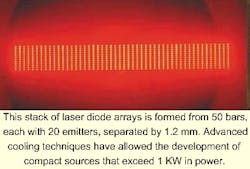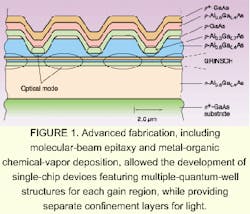Semiconductor Lasers 2000: Designing arrays for power
Single-element multimode diode lasers currently are available with output powers as high as 5 or 10 W. To take full advantage of the superior efficiency and size of diode lasers at higher powers, an array of diodes is needed. Combining numerous individual diode-laser stripes together onto a single chip was the goal of semiconductor-laser research as early as the 1970s. As with other laser-diode research at the time, the prescient vision that inspired this effort was of applications in optical data storage and telecommunications.
Incoherence—it's easier
These applications required the device output to be coherent. Despite some early encouraging results, achieving coherence from a monolithic array proved difficult. A new and less demanding application, pumping Nd:YAG laser rods, made good use of incoherent arrays. The clear advantages of this technology brought laser-diode arrays out of the laboratory and into commercial development in a surprisingly short time span during the mid-1980s. The demands of the diode-pumped solid-state laser (DPSSL) market have led to exponentially increasing power output and lower costs for the arrays. Their success, in turn, has helped underwrite the continuing development of the more complex arrays originally envisioned.
Monolithic diode arrays typically consist of perhaps 10 or as many as a few hundred individual stripes with quantum-well active layers. They use various designs for separate particle and photon confinement, depending on the requirements of the intended application. Designs vary widely, but stripe width is typically measured in microns and separated on a center-to-center spacing several times the stripe width (see Fig. 1). The preferred width for the highest power arrays seems to be 1 cm.Pumps and bars
Diode-pumped solid-state laser pumping and other applications such as materials processing, in which the laser is essentially a source of radiant energy, do not require the laser-diode output to be coherent. The use of gain-guided designs and multimode output from each stripe are typical. Currently, the highest power arrays (also called bars) that are readily available have 40- to 50-W output.
There are two basic pump configurations for DPSSLs: end-pumped and side-pumped. End-pumping, which produces a higher-quality output, concentrates the pump energy along the axis of the solid-state laser rod and places a greater thermal burden on the rod. This, in turn, constrains the power of the pump arrays used in this configuration. The cooling requirements of the arrays themselves in this configuration are readily managed.
The average output power of an array is determined in large part by the effectiveness of its cooling, which is a critical component of these devices. Single diode arrays most often use thermoelectric (TE) coolers, also called Peltier coolers. A good estimate for the cooling capacity of these devices is on the order of 1 W/cm2. Because the footprint of a typical diode array is on the order of 1 cm2, the arrays need to be mated to a large copper block to distribute their heat for TE cooling to be effective.
Really stacked
The highest DPSSL output is achieved with side-pumped designs. This configuration reduces the thermal burden on the DPSSL rod, but the pump arrays themselves require highly efficient cooling. Side-pumped DPSSLs often use two-dimensional stacks of diode arrays. Until relatively recently, the highest-power stacks were limited by thermal constraints to quasi-CW operation. With advanced cooling designs, true CW operation of diode stacks is now commonly available.
Thermoelectric coolers would be ineffective for two-dimensional stacks, which need to have a junction temperature at no more than, say, 50°C, but which generate hundreds of watts or more of waste heat in a volume less than 1 cm3. Two modern cooling designs for stacks are in common use—compact high-intensity cooling (CHIC, also called impingement cooling) and microchannel cooling. These designs operate on somewhat opposing principals.
Way cool
A stack using a CHIC design has each individual diode array bonded to its own copper heat sink. These are attached to a larger backplane-type heat sink, which is actively cooled by an impinging fluid. The CHIC principle uses turbulent flow in the coolant to minimize the thickness of the fluid boundary layer, which forms next to the backplane heat sink and causes a degree of thermal insulation. The CHIC design minimizes the pump power required and keeps the fluid pressure drop low but relies on a series of cooling interfaces to transfer a sufficient quantity of heat.
Microchannel cooling, on the other hand, is essentially a parallel scheme. Miniature channels, short and narrow, are placed directly into the individual heat sinks for each laser array. The flow scheme is also the opposite principle of CHIC in that it relies on fully developed laminar flow in the microchannels to minimize boundary layer thickness. Developed at Lawrence Livermore National Laboratory (Livermore, CA) in the late 1980s, microchannel cooling was made available for commercial use through the laboratory's technology-transfer program.
Both schemes were developed using photoetched microstructures formed on silicon wafers to produce micron-sized structures to control fluid flow (see Fig. 2). The overall result is that a unified stack of arrays can now generate more than a kilowatt of optical power from a total volume of gain region that is on the order of 1 mm3 (see photo at top of this page).Back to coherence
As impressive as is the power output from arrays, their uncorrected beam quality hardly resembles a laser at all. Incoherent sources have beams that are 40 times diffraction-limited and near-field aspect ratios that would be expected of a source with about a 1 µm × 1 cm aperture. Because brightness—maximum power from the smallest emitting surface—is a critical parameter for many applications, manufacturers of arrays are moving to fiber-coupled output to produce a more generically useful beam.
By comparison, the benefits of coherent output are obvious. Using ideas similar to and perhaps borrowed from radar technology, early researchers hoped to lock multiple emitters in phase to achieve coherent output. In addition to optical-storage and telecommunications applications, military uses for free-space communication, such as satellite-to-satellite links, provided funds for early research.
The first phase-locked array, a gain-guided five-stripe device, was reported by Don Scifres' team at Xerox PARC (Palo Alto, CA) in 1978. It was not too long before a phase-locked array of index-guided stripes was demonstrated. Despite these early promising results, achieving reliable single-lobed output proved very difficult. For nearly a decade, stable, diffraction-limited output of coherent arrays just kept pace with the increases in power achieved by improvements to single-stripe, fundamental-mode laser diodes.
The symptoms of the array problems during this time were varied—the beam seemed to prefer to divide into two equal lobes, or the output from a single stripe was very sensitive to changes in the temperature (current) of its nearest neighbors. The basic difficulty was that although each stripe was strongly coupled to its closest neighbors, the overall coupling was weak at best. The output of the array as a whole was not in phase.
Leaky coupling
The breakthrough that occurred in 1989 was the development of the resonant optical waveguide, or ROW, array, which depends on so-called leaky-wave coupling. This principle allowed each stripe to be equally and coherently coupled to every other stripe in the array, while still maintaining a high degree of optical confinement.
Conventional index-guided laser diodes achieve optical confinement by the total internal reflection that results from the high-refractive-index gain region being surrounded by lower-index cladding layers. Light can leak from such a waveguide by means of the “evanescent wave.” Some early phase-locked designs relied on this phenomenon to provide coupling, which turns out to be a fundamentally unstable approach. In fact, ROW arrays must actively suppress evanescent-wave coupling.
Leaky-wave coupling results from antiguided optical confinement, in which the gain region has a lower index than the cladding. Light leaks out of the sides of the gain region, but at a wavelength that differs from the emission wavelength and depends on the stripe width and index differential of the waveguide. This leakage wave is typically around twice the emission wavelength.
Under the proper conditions, energy at this wavelength can resonate with the leakage from every other stripe in the array. All stripes are then locked in phase. Although each stripe is leaking energy, only the end stripes of the array actually lose energy—a minor overall decrease. The ROW arrays tend to naturally select a resonant condition that results in most of the laser emission being contained in a single main lobe.
Other arrays
In addition to ROW arrays, other techniques for achieving phase-locked performance have been developed successfully, including antiresonant-reflective-optical-waveguide (ARROW) arrays, and master-oscillator power-amplifier (MOPA) configurations, in which a frequency-controlled external diode laser provides a source signal that is amplified by a separate diode structure.
Ideally, many of these improvements to array output, along with other desirable features, such as individually addressable elements in the array or an electronically steerable beam, would be integrated into a single truly monolithic structure. In fact, such devices have been under development for some time.
The arrays discussed so far all emit their output in line with the major axis of the gain region—so-called edge emitters. Truly monolithic 2-D arrays of surface-emitting lasers, in particular vertical-cavity surface-emitting laser arrays, promise to surpass edge-emitter performance for many applications in the not-too-distant future.
Next month the series examines controlling the frequency of diode-laser output.
ACKNOWLEDGMENTS
We would like to thank the following individuals and organizations for providing images used in the Semiconductor Lasers 2000 series timeline: Michael W. Davidson, Florida State University; GE Research and Development Center; Zhores I. Alferov; Nick Holonyak, University of Illinois; Dan Botez, University of Wisconsin-Madison; Lucent Technologies, Bell Labs; Connie Chang-Hasnain, University of California Berkeley; Nichia Chemical Corporation; Jack Jewell, Picolight Corp. -Ed.
About the Author
Stephen J. Matthews
Contributing Editor
Stephen J. Matthews was a Contributing Editor for Laser Focus World.


